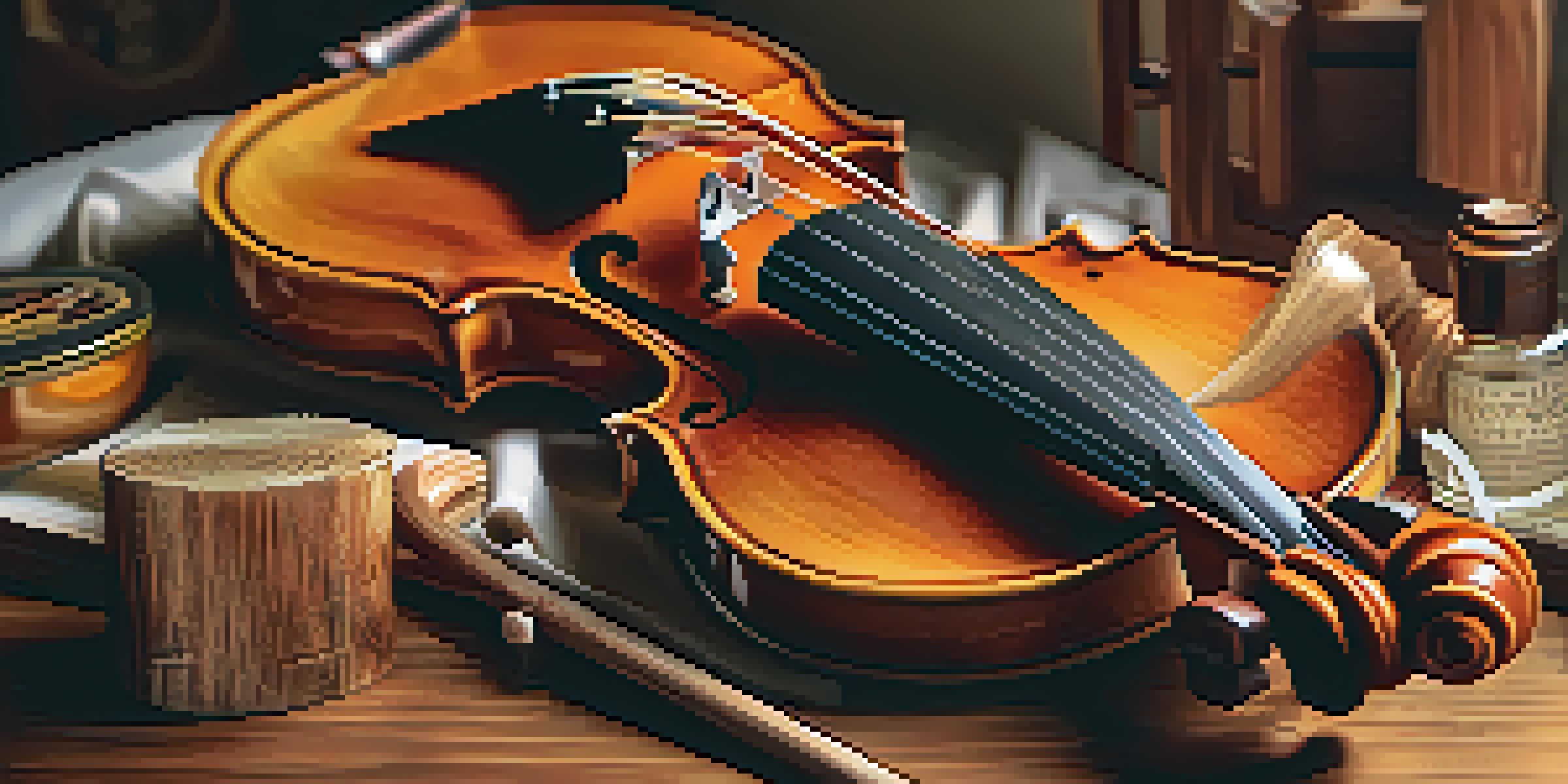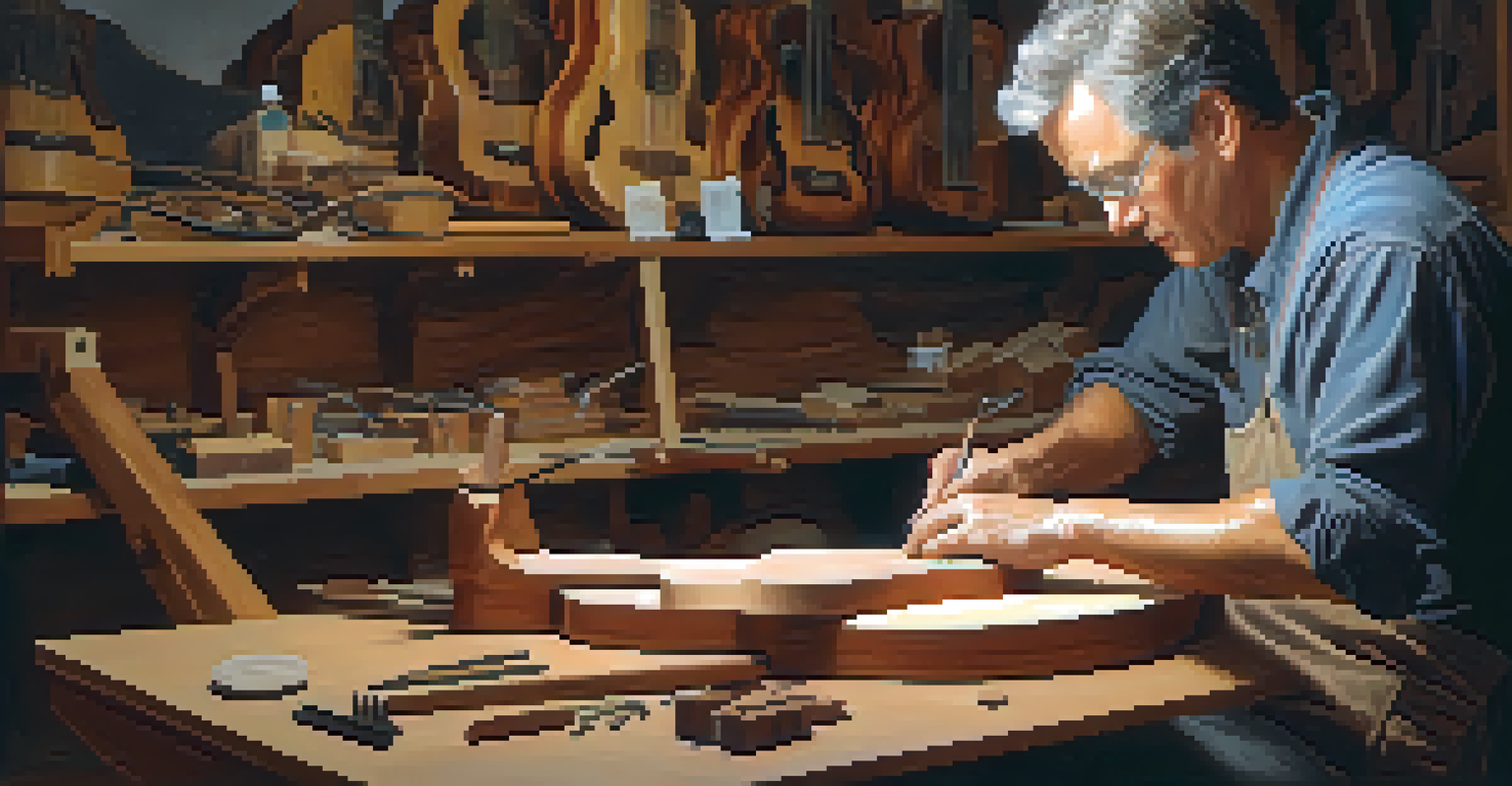The Role of Wood in Carved Instruments: A Cultural Overview

Understanding the Connection Between Wood and Music
Wood has been a fundamental material in music for centuries, shaping not only the instruments we play but also the sounds we hear. From the soft, warm tones of a violin to the sharp, piercing notes of a flute, the type of wood used can significantly impact the instrument’s voice. This connection is deeply rooted in cultural practices across the globe, where different types of wood are chosen for their unique acoustic properties.
Music can change the world because it can change people.
For instance, the resonant qualities of spruce make it a popular choice for the tops of string instruments, while mahogany is often favored for its warm tones. These selections are not arbitrary; they reflect centuries of tradition and experimentation within various musical cultures. Understanding this relationship helps us appreciate the craftsmanship that goes into each instrument.
Additionally, wood's natural characteristics, such as density and grain, can influence how sound is produced and projected. Thus, the choice of wood is not merely aesthetic but deeply intertwined with the instrument’s functionality and the cultural heritage it represents.
Historical Perspectives on Wood in Instrument Making
Throughout history, wood has served not only as a practical choice for instrument crafting but also as a symbol of cultural identity. In ancient civilizations, like those of the Egyptians and Greeks, specific woods were associated with particular deities or rituals, enhancing the spiritual significance of music. This historical context reveals how deeply intertwined wood and music have been across various cultures.

In Europe during the Renaissance, for example, the use of local woods such as maple and ebony became a hallmark of quality craftsmanship. Luthiers, or stringed instrument makers, often passed down their knowledge through generations, emphasizing the importance of using the right type of wood for the right sound. This practice is still evident today, where artisans continue to uphold traditions while also embracing modern techniques.
Wood Shapes Sound and Culture
The type of wood used in instruments significantly affects their sound and reflects cultural practices worldwide.
Moreover, as globalization has influenced music, the sourcing of wood has evolved, leading to both challenges and innovations. The historical journey of wood in instrument making reflects not only technological advancements but also shifts in cultural practices, making it a fascinating area of study.
The Cultural Significance of Different Wood Types
Different cultures have their unique preferences for wood types, each bringing a distinct flavor to the instruments they create. For instance, in Japan, cherry wood is prized for its beauty and sound quality in traditional instruments like the shamisen. The selection of wood often reflects local resources and cultural values, demonstrating a community's relationship with its environment.
The wood is the voice of the tree, each piece has its own story to tell.
Similarly, in Africa, hardwoods such as rosewood and ebony are commonly used in percussion instruments like drums and xylophones, contributing to the rich, vibrant sounds characteristic of African music. The choice of wood not only affects the sound but also ties the instrument to cultural narratives, embodying stories, traditions, and communal identity.
This cultural significance extends beyond just the sound; it influences how music is learned and shared within communities. By understanding the role of different wood types, we gain insight into the cultural expressions and values that shape musical landscapes around the world.
Craftsmanship and the Art of Wood Carving
The craftsmanship involved in creating carved instruments is a blend of art and science, requiring a deep understanding of both wood and acoustics. Luthiers often spend years honing their skills, learning how to manipulate wood to achieve desired tonal qualities. This meticulous process includes selecting the right wood, cutting it with precision, and carving it into shapes that enhance its acoustic properties.
Every curve and contour of an instrument has been thoughtfully designed, illustrating the luthier's expertise and artistic vision. For instance, the arching of a violin's body is crucial for its resonance, and this is achieved through careful carving techniques. The craftsmanship is not merely functional; it reflects a deep respect for the materials and traditions that have been passed down through generations.
Craftsmanship Blends Art and Science
Luthiers combine artistic vision with scientific understanding to create unique instruments that enhance acoustic qualities.
Moreover, this artistry contributes to the uniqueness of each instrument. Just as every tree has its own character, so too does each carved instrument carry the signature of its maker, embodying a blend of cultural heritage and individual creativity.
Sustainability and the Future of Wood in Music
As awareness of environmental issues grows, the music industry faces challenges regarding the sustainability of wood sourcing. Many traditional woods, such as rosewood and mahogany, are threatened by overharvesting and habitat loss. This has prompted a movement towards more sustainable practices, encouraging luthiers and musicians to explore alternative materials without compromising sound quality.
Innovative solutions include the use of responsibly sourced woods, reclaimed materials, and even synthetic alternatives that mimic the acoustic properties of natural wood. These efforts not only help preserve endangered species but also promote a more sustainable future for the music community. Musicians and craftsmen alike are becoming more conscious of their environmental impact, which reflects a broader cultural shift towards sustainability.
This evolution in material sourcing is crucial for ensuring that future generations can continue to experience the rich sounds of carved instruments. By embracing sustainability, the music community not only protects its cultural heritage but also supports the health of our planet.
The Role of Wood in Contemporary Music
In contemporary music, the role of wood in carved instruments remains as vital as ever, bridging traditional craftsmanship with modern musical genres. Instruments like the guitar and violin are still celebrated in various music styles, from classical to rock, showcasing the versatility of wood. This adaptability speaks to the timeless nature of wooden instruments, even as musical tastes evolve.
Moreover, the rise of acoustic performances and a renewed appreciation for live music have led to a resurgence in the popularity of wooden instruments. Musicians are increasingly drawn to the organic sounds produced by wood, often favoring acoustic versions over electronic alternatives. This trend highlights a cultural shift towards authenticity and craftsmanship in music.
Sustainability in Music Materials
As environmental awareness grows, the music industry is shifting towards sustainable wood sourcing to protect natural resources.
As artists experiment with blending genres, the unique tones of carved instruments continue to inspire creativity, proving that wood’s role in music transcends time and style. This ongoing relationship between wood and music keeps cultural traditions alive while encouraging innovation.
Celebrating Wood in Music Festivals and Traditions
Around the world, music festivals and cultural events celebrate the integral role of wood in musical traditions. Events like the International Folk Festival showcase not only performances but also the craftsmanship behind traditional instruments, allowing attendees to appreciate the artistry involved. These gatherings serve as a platform for musicians to share their heritage and for audiences to engage with diverse cultures.
In addition, many cultures have specific rituals or ceremonies that honor the creation of musical instruments from wood. For example, some indigenous communities hold ceremonies to bless the trees before harvesting, reflecting a deep respect for nature and the resources it provides. This connection between wood, music, and spirituality enriches the cultural landscape and fosters a sense of community.

Ultimately, these festivals and traditions highlight the significance of wood in music, reminding us that each instrument carries with it stories, histories, and cultural identities. By celebrating this relationship, we ensure that the legacy of wooden instruments continues to thrive across generations.